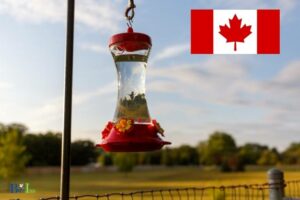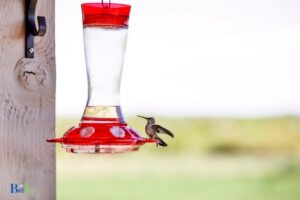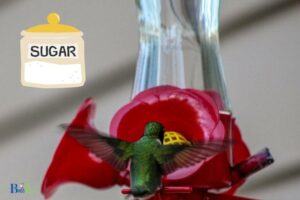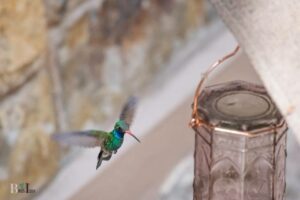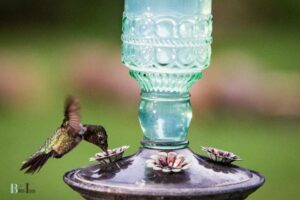How to Attach Hummingbird Feeder: Suitable Location!
To attach a hummingbird feeder, follow these steps: select a suitable location, prepare the feeder, hang it securely, and maintain it regularly for the best results.
Attaching a hummingbird feeder properly is essential not only to attract the birds efficiently but also to ensure their comfort and safety.
By providing a clean and readily accessible source of nectar, hummingbirds will keep coming back to your garden, allowing you to enjoy their presence while helping them meet their nutritional needs.
Regular cleaning is an essential aspect of attaching a hummingbird feeder as it prevents the growth of mold, bacteria, and other harmful microorganisms that can pose a risk to the visiting birds.
Also, keeping the feeder free of ants and bees is crucial to ensure that hummingbirds can access the nectar without being deterred by other insects.
Consider using an ant moat or bee guard to minimize these issues and provide a safe, clean feeding environment for your hummingbird visitors.
8 Steps to Attach Hummingbird Feeder:
| Step | Description |
| 1 | Choose a location for your hummingbird feeder. Select a place near flowers or plants in a shady area to keep the nectar fresh. |
| 2 | Purchase or make a hummingbird feeder. Options include bottle-style or saucer-style feeders, made from glass, plastic, or ceramic. |
| 3 | Prepare nectar for the feeder. Mix 1 part sugar with 4 parts water and bring to a boil. Allow it to cool before filling the feeder. |
| 4 | Clean the feeder thoroughly before attaching it. Rinse it with hot water, using a brush if needed, and ensure there are no sugar crystals or debris. |
| 5 | Attach the feeder to its hanging mechanism. This may include a hook, wire, or chain, depending on the feeder’s design. |
| 6 | Hang the feeder in the chosen location. Ensure it is secure and stable, so it won’t fall or spill. |
| 7 | Fill the feeder with the cooled nectar. Be careful not to overfill, and securely close the feeder to prevent leaks. |
| 8 | Observe and maintain the feeder regularly. Clean and refill with fresh nectar approximately every 3-6 days, more frequently in hotter weather. |
Key Takeaway
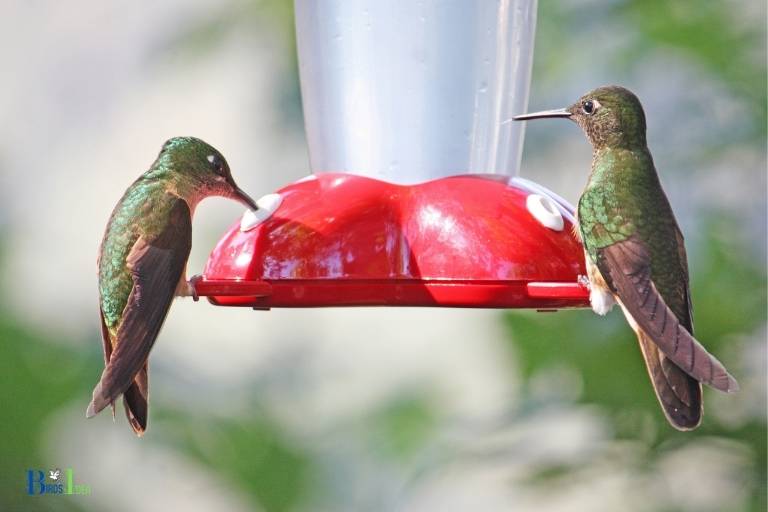
Four Facts About: How to Attach Hummingbird Feeder
Choosing The Right Location
Choosing The Right Location For Your Hummingbird Feeder
Attracting hummingbirds to your garden is a joy. But how do you make sure that your feeder is in a location that’s accessible, safe and appealing to these tiny birds?
Here are some tips on choosing the right location for your hummingbird feeder.
Consider The Sun Exposure And Shade In The Area
Hummingbirds are attracted to bright, sunny areas, but too much sun can cause the nectar to spoil quickly.
Here are some things to keep in mind:
- Choose a spot that gets partial sun and shade during the day.
- Avoid placing the feeder in direct sunlight all day long.
- Consider the timing of the sun in your area and monitor how much sun exposure the feeder gets throughout the day.
Ensure It Is Away From Predators Like Cats And Squirrels
Predators can be a significant threat to hummingbirds, either when they are perched or when they are feeding.
Here are some things to keep in mind:
- Hang the feeder near windows or outside of your desired viewing area, where predators cannot observe hummingbirds visiting the feeder.
- Hang the feeder at a height that’s inaccessible to cats, squirrels, and other predators.
- Hang the feeder one foot or more away from any branches, walls, or other surfaces that predators could jump or climb from.
Make Sure It Is Visible To Hummingbirds
Hummingbirds are attracted to brightly colored flowers and objects, so it’s essential to make sure that the feeder is in a visible location.
Here are some things to keep in mind:
- Choose a spot that’s visible from a distance and has high traffic from hummingbirds.
- Hang the feeder in a location that’s open and easy to see.
- Use brightly colored feeders or add bright red ribbons or flowers to attract hummingbirds.
By using these tips, you can help ensure that your hummingbird feeder is in a location that’s both safe and attractive to these beautiful birds.
Preparing The Feeder
Clean The Feeder Thoroughly Before Use
Before hanging your hummingbird feeder, you should clean it well to avoid any bacteria or mold buildup, which can be harmful to birds.
Here are some steps to follow:
- Disassemble the feeder and remove all the parts.
- Wash each part separately with warm water and mild dish soap.
- Scrub the feeding ports with a brush to remove any dirt or residue.
- Rinse each part with clean water and let them air dry for some time.
Fill The Feeder With Nectar
Once you have cleaned the feeder, it’s time to fill it with hummingbird nectar.
Here are the steps you need to follow:
- Choose a nectar recipe that includes granulated sugar and water in a 4: 1 ratio and mix them well. Avoid using honey as it can promote bacterial growth.
- Pour the nectar mixture into the feeder, filling it to no more than one-third of its capacity.
- Close the feeder’s lid and make sure no nectar is leaking from the ports.
Assemble All Necessary Parts Of The Feeder
Before hanging your hummingbird feeder, you should make sure you have assembled it correctly.
Here are some steps to follow:
- Check the feeder’s manufacturer instructions for the correct assembly order.
- Attach the hanger or hook to the feeder.
- Slide the feeding ports into the base or lid of the feeder.
- Hang the feeder at least 5 feet above the ground, away from windows or other obstacles.
By following these simple steps, you can prepare and attach your hummingbird feeder to your outdoor space, attracting these beautiful birds to your yard. Happy bird watching!
Mounting The Hummingbird Feeder
A hummingbird feeder is a great way to attract these small, colorful birds to your yard. However, you need to mount the feeder correctly to ensure that it is both accessible to the birds and secure.
Here are the steps you need to follow to mount your hummingbird feeder:
Place The Hook Or Hanger In The Desired Location
The first step is to decide where you want to place your hummingbird feeder. Hummingbirds are attracted to a feeder that is in a quiet and shaded spot, away from direct sunlight.
Choose a location that is easy for you to access so that you can refill the feeder and clean it on a regular basis.
Once you have selected the location, it’s time to place the hook or hanger. Make sure that the hook or hanger is at least 5-6 feet above the ground to prevent predators from reaching the feeder.
It’s best to use a hook or hanger that is designed for bird feeders, rather than a generic one, as they are more durable.
Ensure The Hook Or Hanger Is Securely Fastened
Once you have chosen the location and placed the hook or hanger, the next step is to ensure it is securely fastened.
Use a drill or screwdriver to attach the hook or hanger to a sturdy surface, such as a wooden fence or a tree branch.
If you’re hanging the feeder from a tree branch, make sure that the branch is strong enough to support the feeder’s weight.
Attach The Feeder To The Hook Or Hanger
The final step is to attach the hummingbird feeder to the hook or hanger. Usually, hummingbird feeders have a metal loop or wire attached to the top of the feeder. Simply hang this loop from the hook or hanger.
Be sure to hang the feeder level so that the nectar doesn’t leak out of the ports.
Final Thoughts
By following these steps to mount your hummingbird feeder, you’ll ensure that your feathered friends have a safe and accessible place to feed.
Remember to clean the feeder regularly and change the nectar every few days to keep your hummingbirds healthy and happy.
Enjoy the beauty and joy of watching these delightful birds up close in your yard!
Maintaining The Hummingbird Feeder
Hummingbirds are fascinating to watch, and providing them with a feeder is one way to attract them into your yard. However, if you want to ensure that your feeder stays clean and functional, it’s essential to maintain it properly.
Below are some tips on how to maintain your hummingbird feeder:
Regularly Clean The Feeder To Prevent Mold And Bacteria Growth
Hummingbird feeders can be a breeding ground for mold and bacteria.
To keep your feeder clean, you should:
- Clean the feeder with hot water and soap every couple of days if it’s not in use.
- Rinse thoroughly with warm water to ensure no soap residue remains.
- If it has mold or dirt build-up, use vinegar or a solution of 1/4 cup bleach to one gallon of water to clean it.
- Remember to sanitize your hands before and after cleaning the feeder as you don’t want to contaminate it with bacteria from your hands.
Refill The Feeder Daily Or Every Few Days
Hummingbirds are tiny creatures, and they have a high metabolism. Therefore, they require a constant source of fresh food to keep them healthy and active.
To keep your hummingbirds happy, you should:
- Refill the feeder every day or every few days, depending on how many hummingbirds are in your area.
- If you notice that the food has turned cloudy, smells bad or has mold, dump it, and sanitize the feeder with bleach or vinegar before refilling it.
Inspect The Feeder For Damage And Wear And Tear
Hummingbirds can be aggressive, and they can damage or break the feeder. Additionally, exposure to sunlight and weather elements can cause wear and tear on the feeder.
To ensure that your feeder is in good condition:
- Inspect it every time you refill the feeder.
- Check for any cracks, leaks, or damage.
- Replace worn-out parts or damaged feeders as soon as possible
By following these tips, you can keep your hummingbird feeder in good condition and provide a safe and healthy source of food for these amazing creatures.
FAQ For How To Attach Hummingbird Feeder
How Do I Choose The Right Type Of Hummingbird Feeder?
Where Should I Hang My Hummingbird Feeder?
What Should I Put In My Hummingbird Feeder?
How Often Do I Need To Clean My Hummingbird Feeder?
Conclusion
As we conclude our discussion on how to attach a hummingbird feeder, we hope that this guide has been helpful in providing you with detailed steps on how to do it yourself.
Remember to follow the necessary safety tips when handling materials and with the feeder placement, following the guidelines to ensure you attract these beautiful birds to your yard.
Additionally, keep in mind the importance of regular cleaning and maintenance to ensure the feeder is in good condition, and the birds have clean and fresh nectar to consume.
By following these simple steps, you can enjoy observing hummingbirds in your yard throughout the year.
Happy bird watching!

